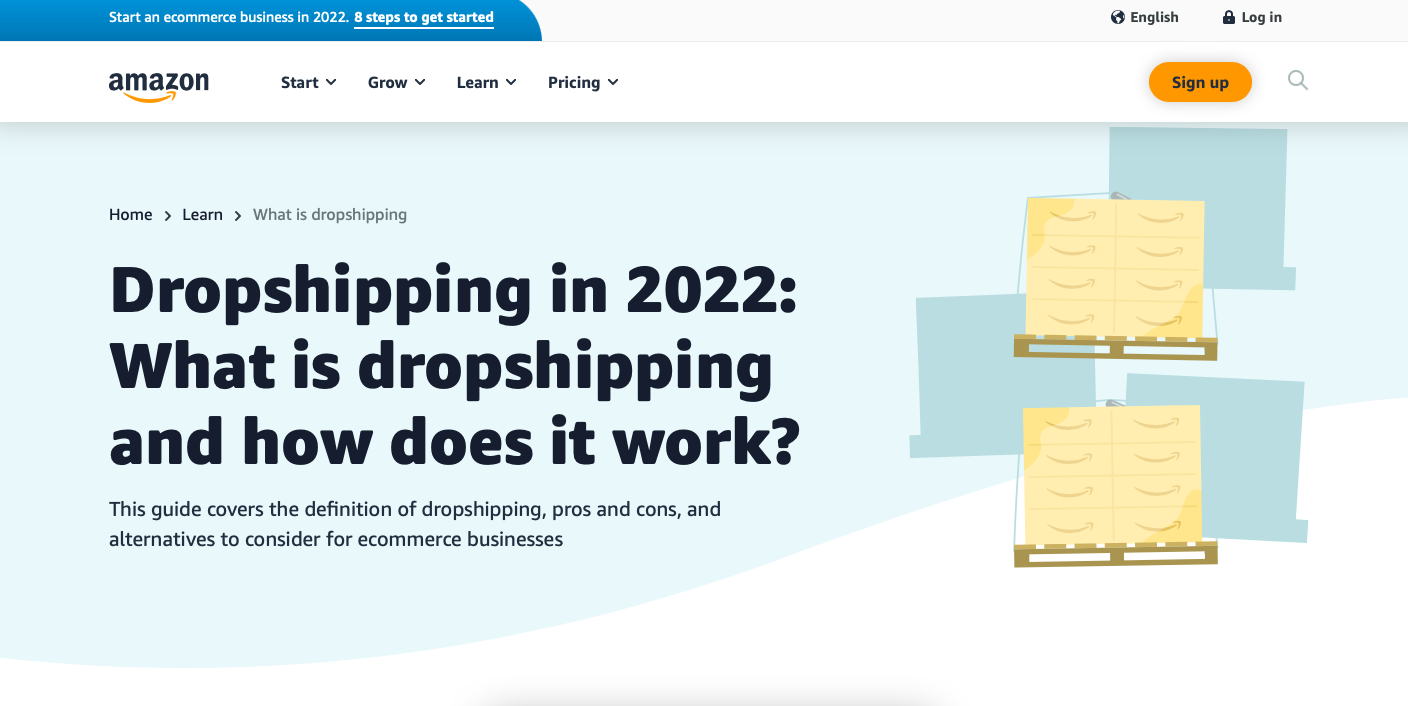Dropshipping is an order fulfillment option that allows e-commerce businesses to outsource the purchase, storage, and delivery of products to a third party. This order fulfillment method appeals to entrepreneurs looking for low overheads and low capital investment, but can be very expensive.
Dropshipping in 2022
E-commerce is competitive. Dropshipping may appeal to entrepreneurs who want to sell generic products, but it can limit opportunities for brand building or product differentiation. Thus, dropshipping businesses can compete on price, resulting in low margins.

If you’re considering dropshipping for your ecommerce business, there are several factors you should consider including some options that offer similar benefits..
What is dropshipping?
Dropshipping allows you, the seller, to outsource the order fulfillment process to a third party, usually a supplier.
The manufacturer or third-party supplier is engaged in the production, storage, shipping and delivery of products to the buyer. This business model appeals to some e-commerce merchants because it can reduce overhead and operating costs.
How does drop-shipping work?
When you work with a dropshipping supplier, you pay them to fulfill your orders. The exact logistics of dropshipping depends on your arrangement, but usually the dropshipping process follows the following general sequence:
- Your dropshipping supplier supplies or manufactures the product.
- You enter into an agreement with a dropshipping supplier.
- Your dropshipping supplier is holding stock.
- You post the listing on the site.
- The customer places an order.
- You are processing the payment.
- You send the order to the dropshipping service.
- Dropshipping service is preparing the order.
- The dropshipping service ships the item(s).
Typically you send customer orders to a dropshipper, then inform customers that the products are on their way and the rest of the physical fulfillment process is out of your hands.
Key players in the dropshipping model
Let’s take a closer look at some of the key players and their roles in dropshipping.
The sellers
The dropshipping process starts with you. As a registered seller, you are the person who sells the product to the end consumer.
You set the price, record the purchase as income, and take responsibility for paying sales tax on that particular sale. Even when a third party stores and ships goods, you are a registered seller because you own the products before they are shipped to the buyer.
For Amazon sellers, use of the dropshipping service is generally allowed by Amazon’s dropshipping policy if you are a registered seller and identify yourself as such
Manufacturers
Manufacturers create products to sell to wholesalers and retailers.
You can purchase goods from manufacturers, but the bulk purchase amounts they may require can potentially be a barrier to starting or scaling your business. Some manufacturers may offer dropshipping services.
Wholesalers
In a typical product supply chain, wholesalers buy from manufacturers and sell to retailers at a small markup. They act as intermediaries; they generally do not sell to end consumers, but may provide dropshipping services to retailers.
Determine which drop-shipping service providers might be right for you based on your business model and fulfillment requirements, among other factors.
Pros and cons
In e-commerce, as in life, every execution approach has its advantages and disadvantages. Whether the profit is worth the effort depends largely on your goals and business situation. Here are the potential pros and cons to consider when evaluating whether dropshipping is right for your ecommerce business.
Possible benefits of dropshipping include:
- Overheads
Because you don’t store or ship products, dropshipping can reduce overhead costs such as maintaining a warehouse or shipping products to customers.
- Start-up costs
Entrepreneurs looking to start a business with minimal investment can turn to dropshipping as they do not need to invest in equipment or resources to process orders.
- Omnichannel sales
You can use dropshipping for your business by selling on your own domain, through a store like Amazon, or social media channels, or all of the above.
- Place of work
Dropshipping allows you to fulfill orders regardless of where you work, opening up the possibility of working from anywhere.
- Scalability
Engaging suppliers allows you to take more orders without increasing the inventory you store, pack and ship.
Potential cons of dropshipping include:
- Competition
Given the low cost and investment to get started, dropshipping is a highly competitive field.
- Product quality
Dropshipping reduces your involvement in the order fulfillment process, reducing your ability to control and guarantee product quality.
- Branding
Because the products you sell may be unique or indistinguishable from similar offerings from other sellers, you may have trouble differentiating your offering.
- Profit margin
The lack of product differentiation means your business may end up with more aggressive price competition. Selling at low prices can eat into your profits.
- Order fulfillment schedule
When the dropshipping service handles the fulfillment process, you have no control over order selection, packaging, and shipping.
- Inventory management
The most recent updates on what is available in stock may not be possible. If a customer places an order only to find that the product is out of stock, such a bad experience can discourage future orders and damage your brand.
- Offer range
Since you are not in the business of fulfilling orders, you may be limited in the special offers and promotions you can run, such as bundling or free shipping.
For some businesses, the downsides of dropshipping do not outweigh the potential benefits. But, if you’re looking to keep your inventory and fulfillment costs low, a service like Fulfillment by Amazon may be right for you. For some sellers, FBA provides the sweet spot by offering many of the benefits of dropshipping without the downsides.
Stay tuned, the second part of the article will be coming soon!
0


